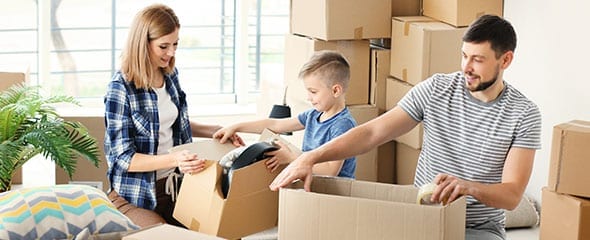Top Tips for Preparing and Packing Your Items for Self Storage

Moving into a Safe n SOUND Self Storage unit is easier than moving house. Here are our top tips for what to prioritise look out for when preparing for your self-storage move:
Clean and Protect What You are Storing
Cleaning and ensuring you protect your things while in storage is one of the basic tenants of successful storage experience. Clean items such as Fridges, Freezers, Washing Machines to ensure that they are free of water and lessen the need to re-clean them when they come out of storage. Cleaning and vacuuming couches, lounges, armchairs and outdoor furniture before storage means that they’ll less likely to smell musty later on. Once these are clean, place them in purpose made lounge and sofa covers to ensure that they are protected from dust. This will also have the advantage of keeping all the cushions are in one place.
To Box or Not to Box?
Many storers get stuck on the decision on whether to use Safe n SOUND Self Storage standard packing boxes or clear plastic containers. Storage requires you to maximise your height which means that you generally use less floor space, making the storage space is cheaper. Storage companies will sell you packing supplies that make the most of the space. Typically the packing boxes will be made to stack to the height of the self-storage unit – generally 3 metres – without losing their structural integrity, because they are uniform in size. Plastic boxes usually have 4 wheels on them which, when stacked on top of each other create a “point load” which means that all the weight of the plastic container and those above it are being focussed on those wheels. The result is generally the plastic lids breaking or cracking and the container having a shorter lifespan, spilling its contents. Cardboard packing boxes are also better for the environment as they can be recycled later on.
Label Your Boxes
When using cardboard packing boxes in the generally accepted method of storing loose items, there is nothing more frustrating than coming back to your storage unit after 6 months looking for an item you know you have but cannot remember which box it is in. Labelling your boxes clearly is key to finding specific items. Use a good quality Marking Pen and follow the naming convention outlined below:
Room: Kitchen
Items: 2nd drawer utility items
Box Number: 2 of 6
This provides an easy reference for you to remember where the item was in the house and therefore its likelihood of being in this particular box. Another tip is to have one box – some call it a safe box – that has key items like the remote controls, keys to various items or items that would be hard to replace if lost; i.e. the bolts to the bed frame! Keep this box towards the front of your self-storage unit and it will allow you to access these things without having to open 10 boxes.
Packing Large Furniture
Whenever possible, disassemble larger items such as beds, cots, outdoor furniture and modular lounges to ensure that you or your removalists have the best chance of finding the best way to store them.
- Keep your mattresses straight up and down and lock them in with another heavy piece of furniture so that they don’t get a “s” in them over time. Make sure you have placed the mattress in a protective cover.
- If possible stand your lounge on its end and stack it upwards, after placing it in a protective cover.
- If you have wardrobes then the best thing to do is to move these into the storage unit empty and then fill them with boxes so that you’re not storing “hollow space”.
- Fridge and freezers can generally have their doors left ajar (wedge some cardboard in between if you need to) to promote airflow and prevent it from smelling musty.
Plan the Packing
As you are starting to fill up the storage space, take the time to think about where the items are going. Storage will always be a trade off between packing the unit to maximum efficiency and being able to retrieve items from time to time. Try and place the items you think you might need, such as the filing cabinet or camping equipment, closer to the front of the unit in case you need to get to them.
Review What Can and Cannot be Stored
Sounds simple right? However, there are some things that just cannot be stored. The basic rule of thumb for self-storage is if you can’t take it on a plane, then you can’t store it. Things such as petrol, paint, thinners, and flammable items like matches, firelighters while fairly common to be stored at home cannot be stored in self storage. These, along with items like fertilisers, fireworks, chemicals and compressed gas cylinders including BBQ and SCUBA Diving tanks cannot be stored either. Other general items such as perishable foods, medicine and plants don’t do well in storage either and should not be stored.
Protect Your Things
As mentioned above you should protect your larger items by using purpose made protectors and drop sheets etc but many people overlook the things that are in a box. Most reputable storage companies will have a regular fumigation program throughout their facility which in most cases will remove any risk from vermin, bugs or spiders however their fumigation will generally NOT get inside your sealed boxes. The use of “mothballs” or naphthalene flakes is a great low cost way to eliminate any creepy crawlies that may have already been on or in your things as you were packing them inside the box. A quick sprinkle of these on the inside of each box before packing and sealing will mean your goods are free of any potential problems from the get go.
Ensure Peace of Mind
Self-storage can be the best experience with a little planning and protection. To ensure that you have peace of mind look for self-storage businesses that have been serving
customers for a long time. They will have everything you need and more importantly have the experience to guide you on the best self-storage practices. Use their knowledge and skill to help you get the most out of your storage unit. Ultimately though for complete peace of mind make sure you investigate and take some self-storage insurance that will cover the replacement value of your goods. This can generally be found through the storage company itself and will typically be cheaper than your household policy per month as it doesn’t need to cover the value of your actual house – just the contents.
Prepared and Ready to Go?
Safe n SOUND Self Storage has been providing self-storage solutions for customers for over 20 years and prides itself on having the best packing supplies and quality boxes ready to go at all of its 11 stores. Providing quality boxes allows you to maximise your space and minimises the headaches of trying to stack irregular sized boxes. Call today to see how we can help you maximise your space whilst providing a large range of furniture covers and some of the lowest Insurance premiums in the market.
